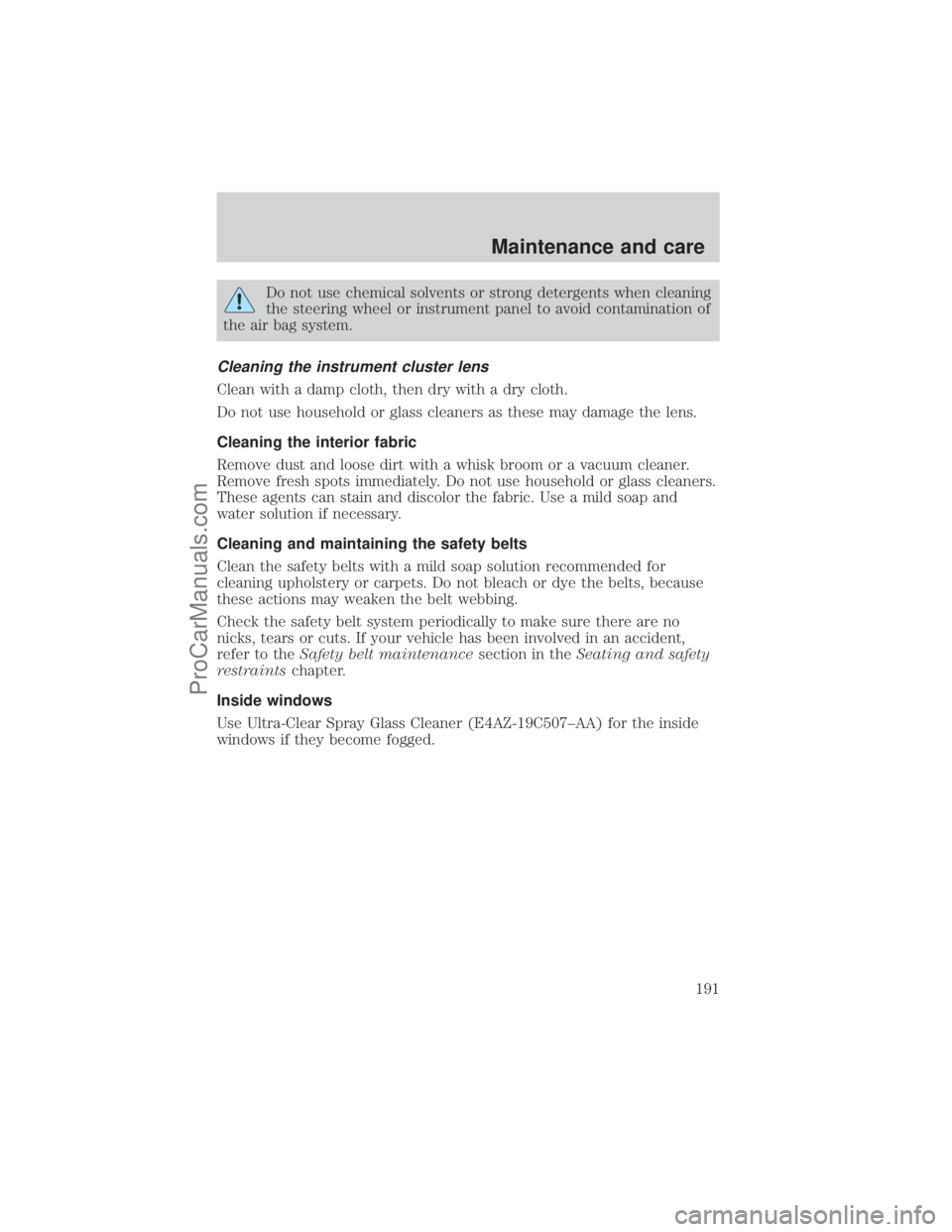Page 136 of 224
Front axle jacking points:
²All models
Place the jack under thepinon the
front surface of the front axle.
Do not place the jack under or
on the steering linkage.
3. Turn the jack handle clockwise
until the wheel is completely off the
ground.
4. Remove the lug nuts with the lug
nut wrench.
5. Replace the flat tire with the
spare tire.
If your vehicle has single rear wheels, thread the lug nuts on the studs
with the beveled face toward the wheel.
If your vehicle has dual rear wheels, thread the two element swiveling
lug nuts on the studs with the flange facing toward the wheel.
6. Use the lug nut wrench to screw the lug nut snugly against the wheel.
7. Lower the vehicle by turning the jack handle counterclockwise.
8. Remove the jack and fully tighten the lug nuts in the following
pattern:
²5-lug wheel
1
4 3
2 5
Roadside emergencies
136
ProCarManuals.com
Page 158 of 224

Check the fluid level when it is at ambient temperature, 20É ± 80É F (-7É
± 25É C):
1. Check the fluid level on the dipstick. It should be between the arrows
in the FULL COLD range. Do not add fluid if the level is within this
range.
2. If the fluid level is low, start the engine.
3. While the engine idles, turn the steering wheel left and right several
times.
4. Turn the engine off.
For E-SuperDuty vehicles with the Hydro-Boost Brake System,
do not press the brake pedal after the engine has been turned
off.
5. Recheck the fluid level on the dipstick. Do not add fluid if the level is
between the arrows in the FULL COLD range.
6. If the fluid is low, add fluid in small amounts, continuously checking
the level until it reaches the FULL COLD range. Be sure to put the
dipstick back in the reservoir.
TRANSMISSION FLUID
Checking automatic transmission fluid (if equipped)
Refer to your scheduled maintenance guide for scheduled intervals for
fluid checks and changes. Your transmission does not consume fluid.
However, the fluid level should be checked if the transmission is not
working properly, i.e., if the transmission slips or shifts slowly or if you
notice some sign of fluid leakage.
Automatic transmission fluid expands when warmed. To obtain an
accurate fluid check, drive the vehicle until it is at normal operating
temperature (approximately 30 km [20 miles]). If your vehicle has been
operated for an extended period at high speeds, in city traffic during hot
weather or pulling a trailer, the vehicle should be turned off for about 30
minutes to allow fluid to cool before checking.
1. Drive the vehicle 30 km (20 miles) or until it reaches normal operating
temperature.
2. Park the vehicle on a level surface and engage the parking brake.
Maintenance and care
158
ProCarManuals.com
Page 191 of 224

Do not use chemical solvents or strong detergents when cleaning
the steering wheel or instrument panel to avoid contamination of
the air bag system.
Cleaning the instrument cluster lens
Clean with a damp cloth, then dry with a dry cloth.
Do not use household or glass cleaners as these may damage the lens.
Cleaning the interior fabric
Remove dust and loose dirt with a whisk broom or a vacuum cleaner.
Remove fresh spots immediately. Do not use household or glass cleaners.
These agents can stain and discolor the fabric. Use a mild soap and
water solution if necessary.
Cleaning and maintaining the safety belts
Clean the safety belts with a mild soap solution recommended for
cleaning upholstery or carpets. Do not bleach or dye the belts, because
these actions may weaken the belt webbing.
Check the safety belt system periodically to make sure there are no
nicks, tears or cuts. If your vehicle has been involved in an accident,
refer to theSafety belt maintenancesection in theSeating and safety
restraintschapter.
Inside windows
Use Ultra-Clear Spray Glass Cleaner (E4AZ-19C507±AA) for the inside
windows if they become fogged.
Maintenance and care
191
ProCarManuals.com
Page 194 of 224
Fluid Ford Part
NameApplication Capacity
Power steering
fluidMotorcraft
MERCONtAT FAll Keep in FULL
range on
dispstick
Rear axle Refer to
Footnote 4Ford 8.8/9.75
inch
conventional and
Traction-Lok2.6-2.7L
(5.5-5.8 pints)
2
Dana 9.75 inch
(M60-IU)3.0L
(6.3 pints)3
Dana 10.5 inch
(M70-2U)3.1L
(6.6 pints)3
Dana 10.5 inch
(M70-1HD)3.5L
(7.5 pints)3
Dana 11.25 inch
(model 80)3.9L
(8.25 pints)4
Fuel tank N/A All regular and
extended length
vans and wagons132.4L
(35.0 gallons)
138 inch
wheelbase
(except E-Super
Duty)140.0L
(37.0 gallons)
158 inch
wheelbase
(except E-Super
Duty)140.0L
(37.0 gallons)
5
176 inch
wheelbase
(except E-Super
Duty)140.0L
(37.0 gallons)
158 inch and
176 inch
wheelbase
(E-Super Duty)208.0L
(55.0 gallons)
Capacities and specifications
194
ProCarManuals.com
Page 220 of 224

P
Panic alarm feature, remote
entry system ................................63
Parking brake ............................103
Parts (see Motorcraft parts) ....192
Power distribution box
(see Fuses) ...............................128
Power door locks ........................61
Power steering ..........................104
fluid, checking and adding ....157
fluid, refill capacity ................193
fluid, specifications .........196, 199
Preparing to
drive your vehicle .....................105
R
Radio ............................................27
Relays ................................124, 131
Remote entry system ...........62±63
illuminated entry ......................65
locking/unlocking doors ...........63
panic alarm ...............................63
replacement/additional
transmitters ...............................65
replacing the batteries .............64
S
Safety belts (see
Safety restraints) ............14, 73±77
Safety defects, reporting ..........215
Safety restraints ....................73±77
belt minder ...............................79
cleaning the safety belts ..82, 191
extension assembly ..................78
for adults .............................74±76for children .........................87±88
lap belt ......................................78
warning light
and chime ......................12±13, 79
Safety seats for children ............89
Seat belts
(see Safety restraints) ...............73
Seats ............................................66
child safety seats ......................89
Servicing your vehicle ..............144
Spark plugs,
specifications .....................192, 199
Special notice ................................4
ambulance conversions ..............4
diesel-powered vehicles .............5
utility-type vehicles ....................4
Specification chart,
lubricants ...........................196, 199
Speed control ..............................50
Speedometer ...............................14
Starting your vehicle ..........98, 100
jump starting ..........................138
Steering wheel
tilting .........................................54
T
Tires ...........................131, 167±169
changing ..........................131, 133
checking the pressure ............169
replacing ..........................134, 170
rotating ....................................169
snow tires and chains ............171
tire grades ...............................168
treadwear ................................168
Towing .......................................112
recreational towing .................119
Index
220
ProCarManuals.com